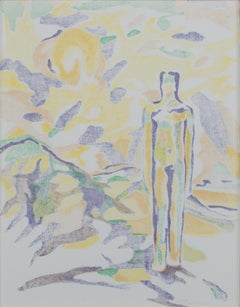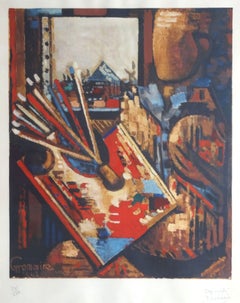Yves Rouvre Art
Yves Rouvre is a French painter and son of the painter Albert Gabriel Rigolot. During his studies, which began in 1937, at the School of Decorative Arts, then in the Free Academies, he worked with his contemporaries, the painters Jean Bazaine, Alfred Manessier and Jean Le Moal, then followed the teaching of Alberto Giacometti and Pierre Tal Coat. During the Second World War, he resided in Tunisia, where he married Germaine Humbert who became his life companion. There, he worked for the architect Bernard Zehrfuss for the "service of architecture and urbanism" of the French Protectorate of Tunisia. In 1949, he spent nine months in French Indochina. Upon his return to France, he moved to Aix-en-Provence with his friend and mentor Pierre Tal Coat. He was encouraged by the painter André Masson who, in 1953, presented his painting to the art dealer Daniel-Henry Kahnweiler. He exhibited as Masson at the Galerie Louise Leiris. After a trip to Greece in 1954, he moved to the Var Plan-du-Castellet.
1960s Modern Yves Rouvre Art
Lithograph
1940s Modern Yves Rouvre Art
Paper, Lithograph
1960s Modern Yves Rouvre Art
Color, Lithograph, Offset
1970s Modern Yves Rouvre Art
Lithograph
1960s Modern Yves Rouvre Art
Lithograph
1970s Modern Yves Rouvre Art
Lithograph, Offset
1940s American Modern Yves Rouvre Art
Lithograph
Mid-20th Century Modern Yves Rouvre Art
Paper, Lithograph
1960s Modern Yves Rouvre Art
Color, Lithograph
Mid-20th Century Modern Yves Rouvre Art
Offset, Lithograph
1950s Modern Yves Rouvre Art
Color, Lithograph
1960s Modern Yves Rouvre Art
Lithograph
1970s Modern Yves Rouvre Art
Paper, Lithograph


